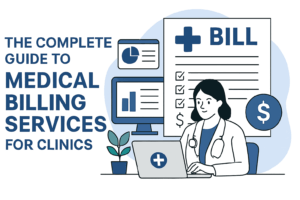Digital Medical Billing Solutions (DMBS) operations rely heavily on claim management. The procedure is complex, with numerous stages that assure the effective handling of medical claims from submission to reimbursement. The fundamental goal of claim management is to streamline the process, decrease errors, limit denials, and ensure that healthcare providers receive timely payments. The following is a detailed examination of the claim handling procedure at DMBS.
1. Claim Submission
The claim management process begins with the submission of claims to insurance companies. Digital Medical Billing Solutions use advanced software to enter patient information, service codes (CPT, ICD-10), and provider information. Claims can be submitted electronically (Electronic Data Interchange – EDI) or on paper; however, electronic submission is recommended due to its speed and efficiency. The software ensures that all relevant fields are completed correctly, reducing the possibility of rejection due to insufficient information.
2. Verification and Scrubbing
Once a claim is submitted, it goes through a verification process to ensure that the information is correct and full. Claim scrubbing software detects frequent problems such as inaccurate patient information, mismatched diagnostic and procedure codes, and missing data. The purpose is to detect and resolve any errors before sending the claim to the payer. This phase is critical since it greatly minimizes the likelihood of claim denials and rejections, resulting in a smoother procedure.
3. Claim Transmission
After verification, the claim is forwarded to the insurance provider. In electronic systems, this transmission occurs virtually instantaneously across secure channels. Paper claims are mailed to the payers. The DMBS software frequently includes monitoring tools that allow billers to check the status of submitted claims, ensuring they reach the payer on time.
4. Payer Adjudication
Once the insurance payer receives the claim, it enters the adjudication phase. During this stage, the payer reviews the claim to determine if the services rendered are covered under the patient’s insurance plan. The payer also checks for any policy exclusions, patient eligibility, and whether the services were medically necessary. The outcome of this process can be a full payment, partial payment, or denial of the claim.
5. Denial Management
When claims are denied or rejected, the DMBS company begins the denial management procedure. This involves determining the grounds for the denial, which might vary from coding errors to eligibility difficulties. Once the cause is determined, the claim can be corrected and resubmitted, or an appeal can be filed. Effective denial management is crucial as it has a direct impact on healthcare providers’ revenue cycles. DMBS frequently use dedicated teams to manage denials, ensuring that all possible channels for payment recovery are examined.
6. Payment Posting
Payments for approved claims are processed and sent to the patient’s account. This stage includes reconciling the payments received with the amounts billed and modifying the provider’s financial records accordingly. Payment posting is an important step since it guarantees that the provider’s revenue records are correct, allowing for better financial management.
7. Reporting and Analytics
DMBS offer comprehensive reporting and analytics tools that provide insights into the claim management process. These tools track metrics such as claim submission times, denial rates, and payment turnaround times. By analyzing this data, DMBS can identify trends, assess the performance of their processes, and implement improvements. Regular reporting also helps providers stay informed about their financial health and claim status, fostering transparency and efficiency.
8. Patient Billing and Follow-up
After the insurance payment, the remaining balance is invoiced to the patient. DMBS firms handle patient billing, deliver statements, and follow up on outstanding accounts. This stage also includes answering patient questions about their invoices, explaining charges, and arranging payment plans if necessary.
Conclusion
Claim management at a Digital Medical Billing Solutions organization is a comprehensive process that necessitates precision, efficiency, and a thorough understanding of healthcare billing. DMBS firms use innovative software tools and specialist knowledge to streamline the claim lifecycle, from submission to payment, ensuring that healthcare providers receive timely and accurate payments. This technique not only optimizes the revenue cycle, but it also improves the financial health of healthcare operations.










